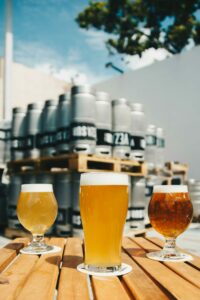The richness of Bordeaux wines is primarily based on the art of blending—a unique signature that sets these wines apart globally. The blending of Bordeaux red wines mainly relies on iconic grape varieties such as Cabernet Sauvignon, Merlot, and Cabernet Franc, complemented by less common varieties like Petit Verdot, Malbec, or even a hint of Carménère. Let’s explore the diversity of these red grape varieties and their unique characteristics.
Merlot: The Generous Red Grape of Bordeaux
Merlot is the most widely planted grape variety in Bordeaux and the most popular in France. Globally, it holds a prominent position among the most cultivated grape varieties. Pomerol and Saint-Émilion are the emblematic terroirs for Merlot, with their cool clay-limestone soils. Its smooth and rounded profile brings wines with beautiful intensity, silky tannins, and ripe red fruit aromas like plum, cherry, and fig. With aging, it often develops toasted and spicy notes.
A cross between Cabernet Franc and Madeleine Noire des Charentes, its name is inspired by the blue-black plumage of the blackbird (merle in French). Formerly known as “Merlau,” “Plant Médoc,” or “Sémillon Rouge,” this grape variety has become essential in creating great Bordeaux wines.
Cabernet Sauvignon: The Iconic Red Grape of Bordeaux Wines
Renowned worldwide for its role in Bordeaux’s great wines, Cabernet Sauvignon embodies the excellence and prestige of the region. A cross between Cabernet Franc and Sauvignon Blanc, this historic grape thrives on the gravelly soils of Bordeaux’s left bank, where it benefits from its late ripening.
Cabernet Sauvignon contributes robust tannic structure, remarkable depth of color, and complex aromas of black fruits (blackcurrant, blackberry), licorice, and mint. Known for its excellent aging potential, it shines in appellations like Médoc, Pauillac, and Graves, where its blends evolve beautifully over decades. Its name, “Carminium,” refers to the deep, intense red hue emblematic of wines from this variety.
Cabernet Franc: The Complementary Red Grape of Bordeaux Wines
An ideal complement in blends, Cabernet Franc is noted for its early ripening and refined tannins. Less colorful than Cabernet Sauvignon, it provides a fresh aromatic profile with notes of raspberry, blackcurrant, violet, and even green pepper. Originating in the Basque region, it spread to southwestern France after the last Ice Age.
Thanks to its finesse and rich polyphenol content, it produces delicate, light wines with floral and spicy aromas.
Petit Verdot: The Red Grape of the Médoc
Often used as a complementary grape in blends, Petit Verdot is a late-ripening variety that adds structure and intensity to wines. Its distinctive aromas of violet and black fruits are sometimes accompanied by surprising banana notes in its youth. Originating from the Pyrenees, Petit Verdot is now cultivated throughout the Graves region. It is particularly prevalent in Médoc appellations such as Haut-Médoc, Margaux, Moulis, and Listrac-Médoc. Its tannic richness and deep color make it a valuable asset in Bordeaux’s finest wines.
Malbec: The Tannin-Rich Bordeaux Red Grape
Rare in Bordeaux vineyards (less than 2% of plantings), Malbec is a dark-skinned variety originating from southwestern France. Known for its robust tannins and dark berries, it is primarily found on Bordeaux’s right bank, particularly in Blaye and Bourg.
Malbec is appreciated for its fruity and spicy aromas (pepper, leather, blackcurrant, plum) as well as floral notes like jasmine. Wines made from Malbec are full-bodied, intensely colored, and tannin-rich. It is often blended with Merlot, Cabernet Franc, or Cabernet Sauvignon, adding depth and character.
Carménère: A Rare Bordeaux Grape
An ancestral grape of Bordeaux vineyards, Carménère is a rarity with a rich and spicy profile. A cross between Cabernet Franc and Gros Cabernet, it is now scarcely found in the region. Its wines are characterized by an intense color, robust tannins, and subtle bitterness, with aromas of red fruits and spices.
Each of these grape varieties plays a key role, contributing unique aromatic and structural qualities. This diversity is what makes Bordeaux wines a global benchmark, celebrated for their elegance and aging potential. To perfect your knowledge and sharpen your palate, join our training course, “Advising and Promoting Bordeaux Wines” here.
Don’t miss out on discovering Bordeaux’s white grape varieties too!








